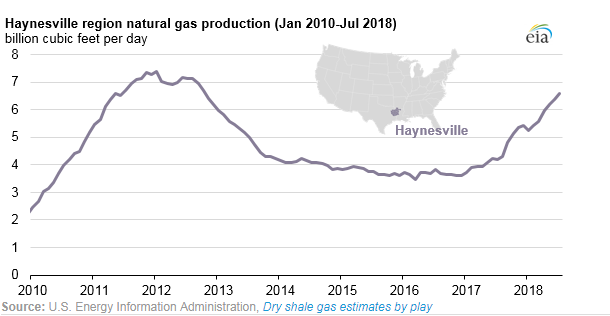
As years of trough has come to an end, the oil & gas industry is apparently recovering with a drastic rise in oil price. Shale gas, a new clean energy resource, is sweeping across the world as it remains eco-friendly while meeting an increasing energy demand. It is recently reported by EIA that shale gas production in Haynesville averaged 6,350 MMSCFD, reaching the highest production of this region since September 2012 (EIA, 2012).

According to Rystad, there were six shale producers who raised their annual capital budget in the second quarter, amounting to 3.7 billion dollars in total, which exceeded early estimation of this year (Rystad Energy, 2018). The rising cost of service accounts for the phenomenon to some degree, but the extra budget was actually made to better support well completion and get prepared for a production boom next year.
Though shale gas industry is facing an unprecedented growth, the extraction of it can be quite difficult out of geological conditions.
Haynesville shale, the Jurassic Period rock formation, is famous for containing vast quantities of recoverable natural gas. Though with abundant reserves, it was once nearly impossible to be extracted since most of it lies at depth of 10,500 feet to 13,500 feet underground, much deeper than most production regions (EIA, 2018).
Likewise, the dilemma applies to other countries too and China is one of them.
As the main battlefields of China's shale gas development, Sichuan and Shaanxi Provinces, which are mountainous areas with shale buried deep, have complicated working environment to operate in.
Multiple factors contribute to this problem including proppant embedment, high operation pumping pressure (90-110 MPa), high fracturing pressure (110-120 MPa), dense reservoir, under-developed fracture texture, obvious horizontal stress difference and natural fracture development as well as high closure pressure (85-95 MPa).
To cope with the situation, Jereh Group, as a leading oil & gas equipment manufacturer within domestic and international market, has already built its own advantages in these areas, especially when it comes to shale gas fracturing.
Jereh innovatively developed Apollo turbine frac pumper that features bigger power, longer operating time yet with a more compact size. It adopted a 5600 hp turbine engine for the first time, which is often applied to helicopters.
The launch of Apollo was historically significant since it marked that China had become the third country in the world to possess a turbine frac pumper after the U.S. . The fact that CCTV (China Central Television) shed light on the story of Jereh and Apollo in its documentary the Pillars of a Great Power had once again proved Apollo a meaningful and innovative creation (Netease News, 2018).
More recently, to cater to local demands, Jereh has made adjustment to the original Apollo turbine frac pumper to better serve American customers.
Independently developed by Jereh, the trailer mounted Apollo turbine frac pumper features smaller footprint, lower cost yet with a bigger power. It adopted a 5,100 hp turbine engine this time, which is often applied to helicopters, and a JR 5000QP super frac pump for higher performance. At the same time, it is able to achieve flexible pump output adjustment through continuously variable transmission. 60-second quick start-up and full load can be realized even without pre-heating. And for the greater good of environment and economy, Apollo can be powered by 100% fuel or 100% natural gas up to client’s option.
Being capable of doubling the efficiency of shale gas extraction compared to regular diesel counterpart, new Apollo has been pre-ordered by American clients and is on production at the moment.
It is not the very first move Jereh takes in North American shale gas market.
Jereh actually made its way overseas a few years back and successfully became the only Chinese manufacturer in the U.S. market back then by providing a whole set of frac fleets to Eagle Ford through cooperation with Shell. And till this day, international sector has taken up to over 50% of Jereh’s overall business.
As the industry sees a bright prospect of shale gas development, Jereh is ready to grab the chance and will concentrate more efforts on developing competitive solutions as well as products for clients in North America and around the world.
Reference:
Ameen, N. (2018). Haynesville natural gas production is increasing but remains lower than previous peak. [online] Eia.gov. Available at https://www.eia.gov/todayinenergy/detail.php?id=37033 [Accessed 10 Sep. 2018].
Rystad Energy. (2018). US shale operators prepped to spend more to produce more. [online] Rystadenergy.com. Available at:https://www.rystadenergy.com/newsevents/news/newsletters/UsArchive/shale-newsletter-august-2018/ [Accessed 10 Sep. 2018].
News.163.com. (2018). http://news.163.com/18/0228/11/DBNQUFRH00018AOP.html